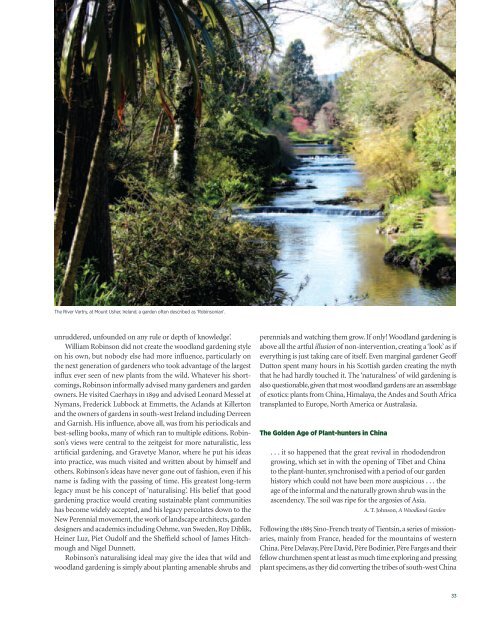Woodland Gardening by Kenneth Cox sample chapters pps 7-42
Woodland Gardening, Published in May 2018 is the first full colour survey on the history and practice of woodland gardening with acid-loving plants: rhododendrons, azaleas, magnolias, camellias, hydrangeas, trees and perennials.
Woodland Gardening, Published in May 2018 is the first full colour survey on the history and practice of woodland gardening with acid-loving plants: rhododendrons, azaleas, magnolias, camellias, hydrangeas, trees and perennials.
Create successful ePaper yourself
Turn your PDF publications into a flip-book with our unique Google optimized e-Paper software.
<strong>Woodland</strong> <strong>Gardening</strong> - prelims and <strong>chapters</strong> 1, 2 and 3 (290mm tall x 230mm wide).qxp 06/01/2018 08:39 Page 33<br />
TREES, SHADE AND SHELTER<br />
The River Vartry, at Mount Usher, Ireland, a garden often described as ‘Robinsonian’.<br />
unruddered, unfounded on any rule or depth of knowledge’.<br />
William Robinson did not create the woodland gardening style<br />
on his own, but nobody else had more influence, particularly on<br />
the next generation of gardeners who took advantage of the largest<br />
influx ever seen of new plants from the wild. Whatever his shortcomings,<br />
Robinson informally advised many gardeners and garden<br />
owners. He visited Caerhays in 1899 and advised Leonard Messel at<br />
Nymans, Frederick Lubbock at Emmetts, the Aclands at Killerton<br />
and the owners of gardens in south-west Ireland including Derreen<br />
and Garnish. His influence, above all, was from his periodicals and<br />
best-selling books, many of which ran to multiple editions. Robinson’s<br />
views were central to the zeitgeist for more naturalistic, less<br />
artificial gardening, and Gravetye Manor, where he put his ideas<br />
into practice, was much visited and written about <strong>by</strong> himself and<br />
others. Robinson’s ideas have never gone out of fashion, even if his<br />
name is fading with the passing of time. His greatest long-term<br />
legacy must be his concept of ‘naturalising’. His belief that good<br />
gardening practice would creating sustainable plant communities<br />
has become widely accepted, and his legacy percolates down to the<br />
New Perennial movement, the work of landscape architects, garden<br />
designers and academics including Oehme, van Sweden, Roy Diblik,<br />
Heiner Luz, Piet Oudolf and the Sheffield school of James Hitchmough<br />
and Nigel Dunnett.<br />
Robinson’s naturalising ideal may give the idea that wild and<br />
woodland gardening is simply about planting amenable shrubs and<br />
perennials and watching them grow. If only! <strong>Woodland</strong> gardening is<br />
above all the artful illusion of non-intervention, creating a ‘look’ as if<br />
everything is just taking care of itself. Even marginal gardener Geoff<br />
Dutton spent many hours in his Scottish garden creating the myth<br />
that he had hardly touched it. The ‘naturalness’ of wild gardening is<br />
also questionable, given that most woodland gardens are an assemblage<br />
of exotics: plants from China, Himalaya, the Andes and South Africa<br />
transplanted to Europe, North America or Australasia.<br />
The Golden Age of Plant-hunters in China<br />
. . . it so happened that the great revival in rhododendron<br />
growing, which set in with the opening of Tibet and China<br />
to the plant-hunter, synchronised with a period of our garden<br />
history which could not have been more auspicious . . . the<br />
age of the informal and the naturally grown shrub was in the<br />
ascendency. The soil was ripe for the argosies of Asia.<br />
A. T. Johnson, A <strong>Woodland</strong> Garden<br />
Following the 1885 Sino-French treaty of Tientsin, a series of missionaries,<br />
mainly from France, headed for the mountains of western<br />
China. Père Delavay, Père David, Père Bodinier, Père Farges and their<br />
fellow churchmen spent at least as much time exploring and pressing<br />
plant specimens, as they did converting the tribes of south-west China<br />
33


